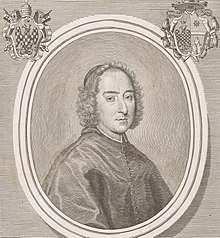Alessandro Albani

Alessandro Albani (15 October 1692 – 11 December 1779) was a Roman Catholic cardinal remembered as a leading collector of antiquities, dealer and art patron in Rome. He supported the art historian,
Biography
Alessandro Albani was born on 15 October 1692 in
in the pontifical military.Alessandro was a member of the
Albani developed into one of the most astute antiquarians of his day, an arbiter of taste in the appreciation of Roman sculpture, and "a powerful and enterprising collector of Roman antiquities and patron of the arts... He used both ancient and modern art as a form of cultural capital," Seymour Howard observed,[3] "giving away acquisitions as favours and selling them for perpetually needed funds or when they lost efficacy for him." His first apprenticeship in this area was served under the papal antiquary and curator Marcantonio Sabatini.[4]
He was the formal protector of Rome's artists as patron of the
His worldly manner and his sympathy with the Hanoverian party in

Albani's accommodating manner suited him for diplomatic tasks, such as the successful negotiations with
As a cardinal Albani participated in the conclaves of 1724, 1730, 1740, 1758, 1769, and 1774-1775. He announced the elections of Pope Clement XIII (1758), Pope Clement XIV (1769) and Pope Pius VI (1775). His consistent stand against French interests brought him closer to those of the Hapsburgs; he represented Hapsburg Austria at the Holy See, from 1756 until his death. On 12 August 1761 he was appointed Librarian of Holy Roman Church.
During the papacy of
He died on 11 December 1779 and was buried in the Observant Franciscan Church of San Pietro in Urbino, Marche.
Villa Albani
Alessandro commissioned in 1745 the construction of the prominent Villa Albani in Rome. Building began in 1751 according to Giuseppe Vasi and celebrated as complete in 1763,[8] to house his evolving, constantly replaced and renewed collections of antiquities and ancient Roman sculpture, which soon filled the casino that faced the Villa down a series of formal parterres. Albani's lifelong friend Carlo Marchionni was the architect in charge, at the Villa and perhaps also for the two temples in the park, an Ionic temple of Diana and a sham ruin. The Albani antiquities were catalogued by the Cardinal's secretary, the first professional art historian, Johann Joachim Winckelmann, who was supported by Albani from the time when the Seven Years' War stranded him in Rome without his pension, and whose own connoisseurship was sharpened by the connection.[9]
After the Napoleonic upheavals the Albani heirs sold the villa to the
Cardinal Alessandro Albani had another villa and park at Porto d'Anzio, that was finished in February 1732,[10] but was habitable for a few weeks only in spring because of malaria. Perhaps the villa and a casina in the park were by Marchionni.[11] Excavations in the park brought to light many ancient Roman sculptures.[12]
Further reading
- Debenedetti, ed., Alessandro Albani, patrono delle arti ... = Studi sul Settecento Romano; 9 (1993)
See also
Notes
- ^ Herbermann, Charles George; Knights of Columbus; Catholic Truth Committee (1913). The Catholic Encyclopedia. The New York Public Library: Robert Appleton Company. p. 255. Retrieved 12 May 2010.
illyricum sacrum albanian.
- ^ Other cardinals of the Albani family include Gian Girolamo (1570), Gian Francesco (1747), and Giuseppe (1801) (Catholic Encyclopedia).
- ^ Seymour Howard, 'Some Eighteenth-Century 'Restored' Boxers', in Journal of the Warburg and Courtauld Institutes; 56 (1993, pp. 238-255) p. 238f.
- ^ Howard 1993:239.
- ^ John Fleming, "Cardinal Albani's drawings at Windsor — their purchase by James Adam for George III", The Connoisseur 142 (1958:164-69; A. Blunt and Cook's catalogue.
- ^ were notorious and Albani was the representative of Maria Theresa in Rome. As Austria's ally, Britain, had no official representation, Albani performed necessary duties
- ^ The Albani-Mann correspondence forms a large part of the documentation of Lesley Lewis, Connoisseurs and Secret Agents in Eighteenth-Century Rome, 1961.
- ^ A brief bibliography of Albani and Villa Albani is given in Howard 1993:239 note 2.
- ^ "Winckelmann, like other eighteenth-century 'Arcadians' before him, served as Albani's ally or minion, not as his director," Howard observes (Howard 1993:239.).
- ^ According to the inscription on a drawing of the villa's ground-plan in the possession of Anthony Blunt, noted in The Burlington Magazine 111 No. 792 (March 1969:164f).
- ^ The casina illustrated in J. Gaus, Carlo Marchionni. Ein Beitrag zur römischen Architektur des Settecento, fig. 47.
- ^ Roberto Piperno, "Rome art lover"
External links
- Cardinals of the Holy Roman Church: Alessandro Albani
- Casino of the Villa Albani
- Cardinal Albani and the Villa Albani, Anzio
- Dizionario Biografico degli Italiani, 1, pp. 595-598: Albani, Alessandro
